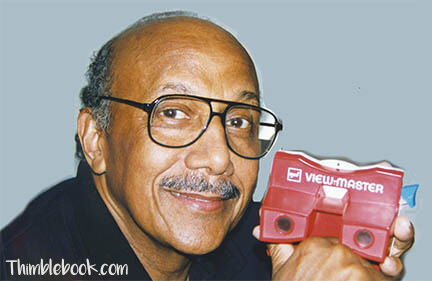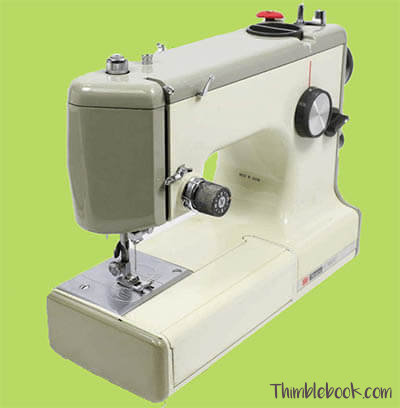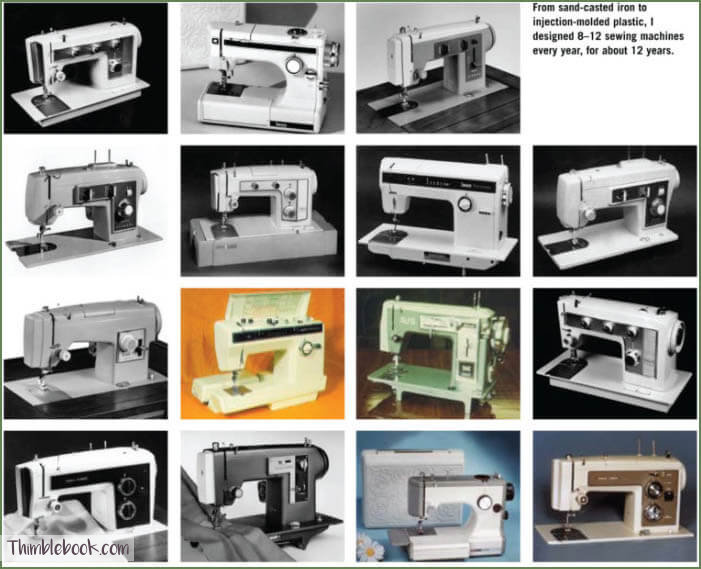Kenmore 1030: A Brief Discussion
*This post may include affiliate links, which allow me to make a small commission off your purchases. The money is earned at no additional cost to you.
I saw a Kenmore 1030 for sale on offer up. Thus, I’ve decided this would be the ideal day to have a discussion about Kenmore 1030 and the 3/4 sized line of sewing machines from the series.

The 3/4 line was designed by Charles ‘Chuck’ Harrison and manufactured by the Japanese Maruzen company. Harrison began as an in-house designer for Sears Roebuck in 1961 and is most known for his work on the view master and the first plastic trash can.
While he did design the view master and the first plastic trash can, he was also responsible for designing 8 – 12 sewing machines per year over a 12 year period. The majority of sewing machines he designed fall into the 158 series. There are 6 machines in the Kenmore mini 3/4 size series. They are the 158.1020, 1030, 1040, 1045, 1050, and 1060.

Kenmore 1030 is small, but not quite small as the Singer Featherweight.
It is small is size, not weight. Kenmore 1030 weighs 15 LBS (17LBS inside the case) , while Singer Featherweight is only 11LBS (15LBS inside the case). To put things into perspective, Kenmore 1030 is around the same weight as a standard sized plastic sewing machine. Due to the weight issue, Kenmore 1030 series isn’t desired much as the Featherweight. However, many don’t mind the weight difference because:
Kenmore 1030 has 4 stitches and a buttonhole, while Singer Featherweight is straight stitch only.
Kenmore 1030 has 4 stitches:
- Straight
- Zigzag
- Zig zag safety stitch (3 stitches to the left and 3 to the right)
- Blind Hem
*Bonus: It also has a 4 step button hole and feed dog drop.

Kenmore 1030 has a robust motor and all metal gears.
Motors in the series fall between 0.8amp and 1amp. The Kenmore 1030 has motor you would find inside a standard sized sewing machine, which is amazing considering the 3/4 footprint. It has a two belt system and runs incredibly quite.
Its got standard parts
The 1030 takes standard low shank presser feet.
It has a regular class 15 bobbin
Surprisingly, this mini Kenmore has the quick needle plate change feature loved by all Kenmore lovers. To change plates, there is a simple lift and flip the metal piece from zig zag stitch to straight. 🙂
The case is really cute!
It comes with a rose covered clam shell case. The case has a nice big handle and is quite impressive !
Here are a few other sewing machines designed by Charles ‘Chuck’ Harrison.

Photo borrowed from “A Life’s Design”
To read more about the Charles Harrison get the book, “A Life’s Design: The Life And Work of Industrial Designer Charles Harrison,” check out his scholarship foundation projectosmosis,or visit Industrial Designers of America.
Other Helpful Articles
Uncovering The Ghost Sewing Machine White Model 477
Everything You Need to Know About Emdeko JA21 Sewing Machine
9 Comments
Leave a response

I was delighted to find this blog entry! For some time now I’ve wanted to know more about Mr. Harrison and read the linked article about him with great interest. Thank you for posting it!
My first very own machine was a superb Kenmore 158-14001 which I was given when I graduated high school in 1969 (yep, I’m ancient) I have a particular fondness for Kenmores and own several that I believe Mr. Harrison designed. One of them is a 1040 that I bought and reconditioned; it runs smoothly, quietly and is a joy to work on. I also have a 1060 that still needs a little fixing; hopefully I have that one running again soon. My little 1040 will handle just about anything except heavy denim or upholstery fabric. It’s exceptionally good with knits and “loves” twin needles so I use it quite a bit. I have a few modern machines that I use regularly and appreciate their “bells & whistles” but my vintage babies will still be running strong long after the modern ones have gone to the trash heap.
Wow Kenmore 158 models are great. I especially like the 14001 🙂 You are so right about the longevity of vintage machines vs the new ones. Thanks for visiting the blog.
Hmmm…I own one of these machines and it has separate zigzag/straight stitch plates. It DOESN’T have the trademark insert that pops out and flips around.
I have two separate plates too. However, there are other models that do have the trademark reversible plate. I must admit, a reversible plate is a super cool feature!
When you consider that the wooden Featherweight case is heavier than the Kennie’s plastic case, that narrows the weight gap a bit. The Kennie is only a couple pounds more when fully loaded and packed up in its case.
I have a sweet 1030 but the little case was empty. Would love to get original feet, screwdrivers, and plate. The contents that should have been in the little box.
I wish that I could have better advice. But, the best thing to do is search kenmore sewing machines on eBay. Scrolling thru the many pages, you can find parts boxes and accessories. If you do know exactly what you are looking for, you can find all the original accessories. This is the same thing I had to do for my Emdeko. The process took around 6 months.
what is the lever that is kind of under the accessory box? I can’t figure out what it’s for. It’s on the outside front of the machine to the far right of the bobbin case area, bu two the left of the motor.
Are you speaking of the feed dog drop?